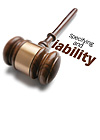I am not an engineer. I’m only an attorney. Engineers usually don’t even like to talk to lawyers, so I was very surprised to be asked to write an article for a plumbing and mechanical engineering magazine.

If you specify on any engineering project, you need to protect yourself.
I am not an engineer. I’m only an attorney. Engineers usually don’t even like
to talk to lawyers, so I was very surprised to be asked to write an article for
a plumbing and mechanical engineering magazine.
I’ll keep the tone of this article informal. Just as if you and I were friends.
If I had not told you I was a lawyer, maybe we even could’ve been friends.

Keeping It Informal
Some of the best advice I’ve given as a lawyer was informal-when I also was temporarily transformed into a human and chatted with friends over coffee or dinner. I find that both sides act differently when there is no meter running and when conversing with others who we care about personally, not just professionally. Of course, all lawyers do genuinely care about their clients. But that kind of care is naturally different than the care felt for a family member, relative or friend. With a client, an attorney is always acting with all appropriate professional “shields up, Scotty.” With an “unshielded,” “unguarded” conversation, advice comes more from the “gut” or from the heart, not just books, case law, Latin legal phrases and statutes.This kind of legal advice is similar to inviting your doctor’s personal (not just professional) advice: “What would you advise, doctor, if you were making this decision for your own family member?” Doctors are required, by their professional standards, by the law and by their medical malpractice insurance carriers, to fully disclose to their patients every possible risk of a specific surgical procedure. Otherwise, you can sue them simply because they failed to give you enough information to make an “informed decision.” But you would really still like to know what the doctor would advise if the patient was his own mom. I have used that technique with doctors. It works. The same goes for lawyers. There is the advice that doctors, or attorneys, must give-and there is the advice you’d like to have. I’d venture to say that engineers are the same.
Since you are reading this article, you are involved in the plumbing and mechanical engineering profession, and you are inclined toward staying professionally current. You understand your profession is fraught with legal, ethical and financial risks, and you must endeavor to manage an annoying, non-billable administrative part of your multi-tasking professional life.
(Personally, I consider engineering jargon so far over my head it gives me a headache. Whenever I deal with engineers, I need an interpreter and a bottle of aspirin.)

Five Legal Principles You Need to Know
I’ll share with you five very unofficial, but very real, legal principles you need to know about that are not defined in Black’s Law Dictionary. These five are, jointly and separately, reasons you should always consider yourself a potential target of a lawsuit if and when anything ever goes wrong with a project you have affixed your seal to.1. Anyone Can Sue Anyone for Anything at Anytime. And dammit, they sure do. Ours is a litigious society that seeks to right many private wrongs by throwing money at that wrong. The money usually comes from the person who allegedly committed some portion of the wrong and goes to the “victim(s),” and of course, a healthy percentage to their attorneys. Money, especially large quantities thereof, has motivated, and shall continue to motivate, the creation of theories of liability we have yet to dream of. To withstand the deluge of creative legal liability theories, you need to practice prompt, proactive, creative Preventive Law.
2. Deep Pockets.Injured parties, and their lawyers, always look to recover from those who have the deepest pockets. It makes much more sense to sue the owner of the project and the engineering firm than the plumber’s gopher who did not tighten the widget sufficiently to prevent the catastrophe. Everyone assumes that P.E.s, like attorneys, are all wealthy; therefore, you will find fingers reaching into your pockets that are not attached to your own hand.
3. Shotgun Theory.With statutory time limits hanging over their heads, along with their own malpractice concerns, attorneys do not dare make the mistake of failing to name any party who may have contributed to the actual cause of the catastrophic event. They are compelled by prudence to name every possible responsible party who may have contributed, in any remote manner, toward the happening of the event.It may be almost impossible at the commencement of a suit to determine who the actual responsible person(s) are, so the attorney’s rule of thumb is to sue everyone who is in any remote manner even slightly related to the project. Hence, the wide shot pattern of the shotgun theory. Trust me, as a specifying engineer, you are within the shot spread of that wide bore shotgun.
4. Free Expert Testimony.Some attorneys, especially those with not-so-affluent clients, understand that by naming the design engineer/architect as a party defendant in a legal action, they automatically get the right to examine you, under oath, without having to pay you as an expert witness. If you play nice with them, they may even let you buy out of the lawsuit cheap.
5. Divide and Conquer.Once the lawsuits start flying, everyone finds their relationships dramatically altered. Everyone goes directly into CYA (Cover Your ASSets) mode. The owner/contractor that you were best friends and a strong business ally with last week has now been advised by his attorney that his interests and yours are potentially adverse and that such attorney cannot provide you with the indemnity or courtesy defense you were expecting. Likewise, the insurance company of the owner/contractor says they cannot defend anyone but their own policyholder, regardless of what any contract says. Effectively, the plaintiff of a lawsuit has now divided you from your expected allies, and you are on your own now to pay your own counsel fees, court costs, deposition costs, travel expenses, etc. Plus, if there is any verdict or settlement in favor of the Plaintiff, you will be expected to contribute a portion. If you and your former allies are now at odds, each of you will throw blame at the other, all to the benefit of the Plaintiff who started the lawsuit.
Twelve Ways to Protect Yourself
So, Mr. or Ms. P.E., what can you do to protect yourself against lawyers at the gates? Here’s a dozen “always” hints, “never” hints and one “constantly” tip.1. Always have a written contract with the owner/contractor.
2. Always involve your own legal and insurance counsel early in contract negotiations.
3. Always preserve original documentation.
4. Always have insurance that covers you-not just the owner’s/contractor’s policy.
5. Always believe that the project you are working on today is a lawsuit awaiting and CYA.
6. Always specify disclaimers, written warnings, warning placards/signs, etc.
7. Never compromise safety.
8. Never act outside your area of expertise.
10. Constantly educate yourself about liability prevention and mitigation.
11. Never guide your legal affairs by the contents of any magazine article-consult counsel.
12. Never tell lawyer jokes.
Some insurers of P.E.s offer educational materials to their clients. Any insurance carrier that makes such an affirmative effort to help you preserve the contents of your pockets is worthy of your consideration.
Bonus Practice Tip: Any plan or spec that you seal should contain a conspicuous warning, such as this one that would apply under New York laws. If it were my seal, I would put the following warning in double-large, bold, underlined print on the cover page, and also, in smaller, but legible print, on every page of every plan and spec. Sometimes a sub will only receive a few pages of the entire master plan. If the warning is not on those pages, the sub is not fully informed. Do you want to ask a jury whose fault that is?
WARNING: These plans and specifications are each part of an integrated design system. Any modification, alteration, change, deletion, addition, or substitution, of or to any specification(s) could result in property damage, injury, or even death, and requires a full review of the entire system by a professional engineer. Any unauthorized modification of this document may constitute unlicensed practice as a Professional Engineer and may constitute a Class E Felony (NY Education Law § 6512.1).
There are literally volumes that could be written about the subject of managing your professional liabilities as a P.E. However, I’ll sign off with just saying thanks to all you professional engineers who make it a safer, better-smelling, faster-flushing-with-less-water world. Ed Ballanco (Julius’ dad) would have liked it with less water in that last flush.

Sidebar: This Lawyer's Poignant Recollection"
I confess that there’s been a few times that I have looked at past copies of PM Engineer magazine. That was only to read articles authored by my friend, Julius Ballanco, P.E. He and I have shared many miles in a canoe and lots of miles in business endeavors. I am always interested in seeing just how much trouble JB can get himself into in any one article.Julius and I were shovel operators and hand dug sewer trenches (they wouldn’t let either one of us use the backhoe or any power tools) together when we were young, and we both worked for his dad, Ed. Julius’ dad was like a second father to me. I learned a lot about life with him in sewer trenches. [I wonder if having literally been “in the trenches” gains me any credibility in a plumbing-related magazine.]One poignant recollection was watching Ed Ballanco put on his chest-high wader boots because the most efficient connection for one particular house was through the existing septic tank. As Ed donned his waders, he broke into the old Don Ho melody: “Everything is Beautiful.” I stood there shaking my head at how this man could be singing so cheerfully as he was about to enter the circular arena of aromatic excrement.Of course, we asked the residents of the house to not flush while Ed would be in the arena. Invariably, some unthinking inhabitant would find it necessary to use the facilities and depress that little metallic handle that sends stuff on its merry way downhill. Well, let me tell you, all of us (Julius included), would display incredulous facial expressions as we heard the gurgling noise that announced the coming arrival of the newest tank contents.
That anyone would dare flush after our warnings not to do so was beyond comprehension. How could they do that? We half expected Ed to make a mad dash (I know I would have) for safety above the high tide marks of the tank-but no, with the staid, stoic calmness of a bullfighter sidestepping a raging adversary, Ed would simply step slightly aside and allow the charging torrent to go by him without harm. Just as the rest of us high-and-dry onlookers would all be vicariously panicked on his behalf, when the telltale gurgle commenced, Ed would calmly change to Don Ho’s other famous tune, “Tiny Bubbles.” You have to love a man with that much grace under fire. Ed Ballanco is a man worthy of being remembered.